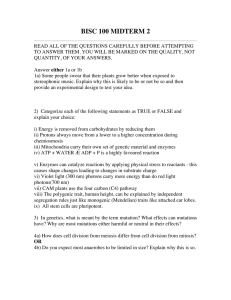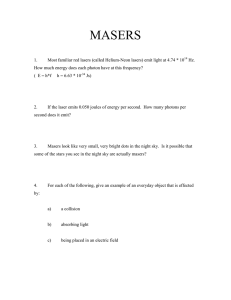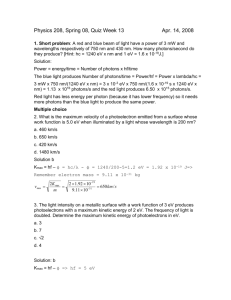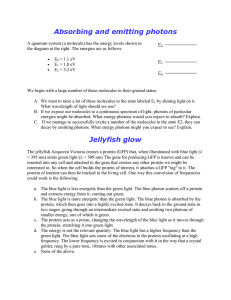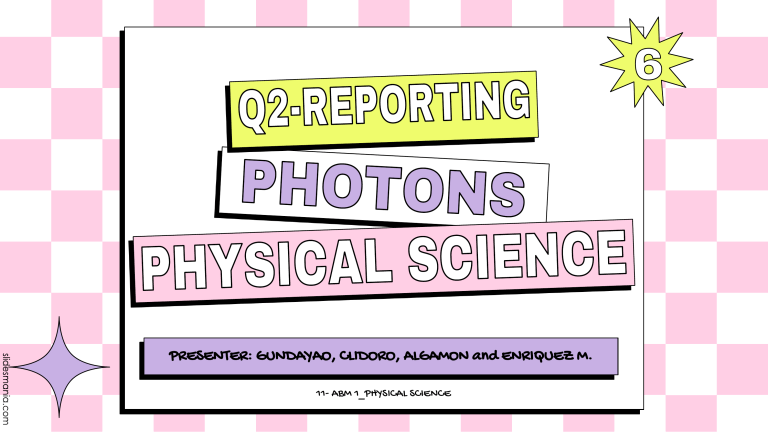
PRESENTER: GUNDAYAO, CLIDORO, ALGAMON and ENRIQUEZ M. 11- ABM 1_PHYSICAL SCIENCE TARGETS: ✎ ✎ ✎ Identify the properties of photons; Describe the history of the discovery of photons; and Explain how the relationship between the energy Of a photons and its frequency can be used to explain why red light is used in photogenic dark rooms, why we get easily sunburned in ultraviolet light but not in visible light and how we see colors. PHOTON Photons are a bundle of electromagnetic energy. It is the basic unit that makes up all light. PROPERTIES OF PHOTONS PRESENTER: SOPHIA GRACE GUNDAYAO PROPERTIES OF PHOTONS This are the properties of photons Photons have zero mass and rest energy. It only exists as particles in motion. Photons are stable. Photons are elementary particles even if it has lack of rest mass. Photons are spin-1 particles which converts them bosons. Photons can interact with other particles like electrons in the Compton Effect. Photons can be destroyed or created by different natural means, for example when radiation is absorbed or ejected. Photons have zero electric charge. Photons have energy and momentum which are dependent on its frequency. Photons travel as fast as speed of light when in empty space. HISTORY OF PHOTONS PRESENTERS: MICHAELA ALGAMON & SARAH MARIE CLIDORO In the late 1800s - proposed his theory of electromagnetism, which described the interactions between electric and magnetic fields. JAMES CLERK MAXWELL In the early 1900s - made further contributions to the understanding of light and the photon. In 1905, he proposed that light was made up of packets of energy, which he called “quanta.” He showed that the energy carried by each quantum was proportional to the frequency of the electromagnetic wave. ALBERT EINSTEIN Over the years, the understanding of photons has continued to evolve. In the 1920s and 1930s, quantum mechanics was developed, which provided a deeper understanding of the behavior of photons. It showed that particles like photons could exhibit both wave-like and particle-like properties, depending on how they were observed. Further research in the mid-1900s showed that photons could be created and destroyed under certain conditions. This led to the development of new technologies like lasers and fiber optics, which use the properties of photons to transmit information over long distances. DEFINITION OF TERMS: QUANTUM • is the smallest elemental unit of a quantity, or the smallest discrete amount of something. The plural of quantum is quanta. ELECTROMAGNETIC WAVE • Is an energy-carrying wave emitted by a vibrating charge (often electrons) that is composed of oscillating electric and magnetic fields that regenerate one another. LIGHT • It refers to electromagnetic radiation of any wavelength, whether visible or not. ENERGY It is the capacity for doing work. FREQUENCY It is the number of waves that pass a fixed point in unit time; Today, photons continue to play a key role in our understanding of the universe. They are used in scientific research, medical imaging, and telecommunications, among many other applications. HOW THE RELATIONSHIP BETWEEN THE ENERGY OF A PHOTONS AND ITS FREQUENCY CAN BE USED TO EXPLAIN WHY RED LIGHT IS USED IN PHOTOGRAPHIC DARK ROOMS, WHY WE GET EASILY SUNBURNED IN ULTRAVIOLET LIGHY BUT NOT IN VISIBLE LIGHT AND HOW WE SEE COLORS. PRESENTER: MYKAELA ENRIQUEZ The particle of light and the energy of photon is DIRECTLY PROPORTIONAL to its frequency. ELECTROMAGNETIC SPECTRUM Free themes and templates for Google Slides or PowerPoint NOT to be sold as is or modified! Longer Wavelength Lower Frequency Lower Energy Read FAQ on slidesmania.com Do not remove the slidesmania.com text on the sides. Sharing is caring! Shorter Wavelength Higher Frequency Higher Energy The relationship between the energy and frequency that the higher the frequency, the higher the energy and given by the equation E = hf E = Energy h = Planks Constant f = Frequency • Why RED light is used in photographic dark rooms? Darkrooms used red lighting to allow photographers to control light carefully, so that light-sensitive photographic paper would not become overexposed and ruin the pictures during the developing process. • Why do we get easily sunburned in Ultraviolet Light but not in Visible Light? The energy of photons is proportional to their frequency. Ultraviolet light has a higher frequency than visible light which indicates that it has higher energy also. This means that UV is sufficiently energetic to cause skin damage while visible light is not. • How do we see colors? Light travels into the eye to the retina, located on the back of the eye. The retina is covered with millions of light receptive cells known as rods and cones. When these cells detect light, they send signals to the brain. These three cones are as follows: the L cone is photosensitive to red (long wavelength), the M cone is photosensitive to green (middle wavelength) and the S cone is photosensitive to blue (short wavelength).

